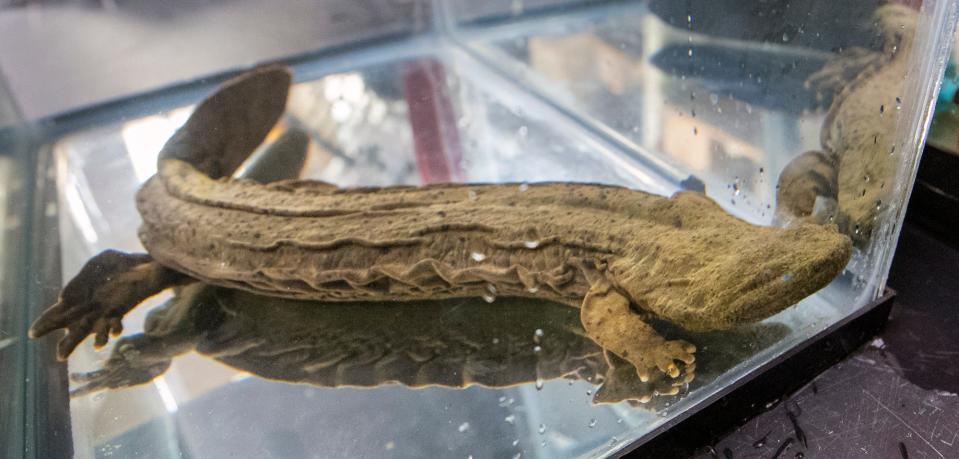The hellbender gets a reprieve: Judge orders the feds to reconsider endangered status
The eastern hellbender – a large salamander that also goes by the sobriquets “grampus,” “devil dog” and “snot otter – was on the way out.
It seemed that human beings had it in for the hellbender. Encroaching development in watersheds and the resulting decline in water quality was decimating the species.
Dr. Peter Petokas, a research biologist at Lycoming College’s Clean Water Institute, made it his academic life’s work to save the hellbender. “I’ve spent 18 years studying the hellbender,” he said. In his small lab, he has raised hellbenders to be introduced into the wild. In the field, he and his associates and students have constructed shelters and habitats for the critters.

Ironically, when the Center for Biological Diversity petitioned the federal government to extend endangered species protection to the snot otter, the U.S. Fish and Wildlife Service denied the request, citing the efforts of Petokas and other scientists around the country to increase hellbender populations.
It didn’t make a lot of sense to Petokas, considered one of the nation’s experts on hellbenders. The service asked Petokas and other experts what hellbender populations would be in 10, or 20, or 100 years. Petokas couldn’t answer that question. “There was no way to project that far into the future,” he said.
What was needed was endangered species protection, he, and others interested in saving the hellbender, concluded.
After the Fish and Wildlife Service denied the protection in 2019, the Center for Biological Diversity lawyered up the hellbender and sued to reverse the decision.
And now, it can be said that the hellbender – the official amphibian of the Commonwealth of Pennsylvania – has been granted a judicial reprieve.
Previously: The hellbender lawyers up: Conservationists sue for endangered status for Pa. state amphibian
A federal district judge in New York ruled last month that the Fish and Wildlife’s decision to deny protection to the hellbender was “unlawful” and “arbitrary,” relying upon measures that had not yet been implemented or proven effective. The judge ordered Fish and Wildlife to reconsider its decision consistent with the law governing endangered species.
“This is an amazing win,” said Ted Evgeniadis, who, as the Lower Susquehanna Riverkeeper, was a party in the suit.
The ruling could have a great impact on water quality, Evgeniadis said. Protecting habitats for hellbenders would make it more difficult to develop in watershed areas, which would result in improving water quality.
It is not a done deal, though. The ruling only orders the Fish and Wildlife Service to reconsider its decision not to grant the hellbender protection under the Endangered Species Act.
All about the hellbender: Hell-bent for Hellbenders: 'The canary in the coal mine' of the Susquehanna River watershed
But it does give advocates hope. “We hope that Fish and Wildlife will do the right thing this time around,” said Elise Bennett, a senior attorney for the Center for Biological Diversity.
The hellbender is often referred to as the canary in the coal mine in the watersheds it calls home. It needs clean water to survive and declines in its populations often signal that water quality is going downhill.
Researchers have found that nearly 80 percent of hellbender populations have already been lost or are in decline – a fact that the Fish and Wildlife Service ignored when it rejected endangered species status in 2019. That decision, advocates said, was political, as the Trump administration had attempted to roll back environmental regulation during its tenure.
The hellbender was once widespread in 15 states and in the Susquehanna River watershed. Petokas said as much as 95 percent of the hellbender’s habitat in the Susquehanna watershed is gone.
As Evgeniadis said, “They don’t have many homes left.”
Advocates are now hoping that Fish and Wildlife will issue an expedited timeline for its decision and that a final determination can be made by the end of next year by the latest.
Columnist/reporter Mike Argento has been a York Daily Record staffer since 1982. Reach him at mike@ydr.com.
Killing the Chesapeake: PA's polluted Susquehanna River is poisoning the bay. What can be done
This article originally appeared on York Daily Record: A judge ordered feds to reconsider endangered status for hellbender

